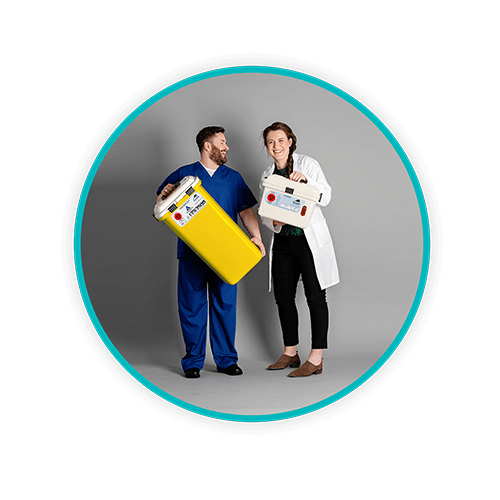New York City Healthcare Waste Management Tips

According to Becker’s Hospital review, New York City is home to 62 acute care hospitals and still growing. You know how many beds that is? 23,762! Yes. We counted. That number doesn’t include nursing homes, long-term care centers, rehab facilities, or ancillary medical facilities such as outpatient centers, cancer treatment centers, dialysis facilities… and yes, we could go on.
Bottom line: that’s a lot of beds, medical services, and healthcare waste. When it comes to biomedical waste management, New York City has to know their stuff. New York’s State Department of Health, the Wadsworth Center, and the Department of Environmental Conservation (DEC) jointly administer New York State’s regulated waste management program. What exactly does that mean?
It means that any medical facility that produces potentially biohazardous waste must be educated and familiar with the statutes and regulations for medical waste management in New York City as well as the entire state.
Who regulates what?
In New York City, the Regulated Medical Waste Program (Wadsworth Center) oversees storage, treatment and biohazard waste management in terms of disposal of healthcare waste that’s produced by:
- Residential healthcare facilities
- Hospitals
- Diagnostic and treatment centers
You can find the regulations under Section 2801 of the Public Health Law. Is also oversees storage treatment and regulated waste disposal for clinical laboratories (Section 571 Public Health Law).
The Department of Environmental Conservation (DEC) has authority over on-site facilities that are not under Department of Health jurisdiction for off-site transport of regulated medical waste, and for generators. It oversees tracking, response to non-compliant (illegal) disposal incidents, as well as off-site storage, transfer, treatment and disposal facilities.
Is your facility familiar with the regulatory programs of the Wadsworth Center? You should be. The regulatory programs provide information and valuable resources in the guidance and standards for compliant biomedical waste management for all New York State licensed healthcare facilities.
A few of the regulatory programs under the purview of the Wadsworth Center include:
- Waste management plans
- Alternative technologies
- Statutes and regulations
- Checklists, guidelines, and approved technologies
For example, the Department of Health provides access to a downloadable waste management plan checklist that is in accordance with city codes, rules and regulations. The development of a workable medical waste management plan and strategy options can be customized to specific facility needs.
For specifics regarding statutes and regulations for the state of New York and applicable to New York City look to the Public Health Law, Article 13, Title 13 (Storage, treatment and disposal of regulated medical waste section 1389-aa to 1389-gg). Specifically, New York City facilities should also strictly adhere to New York City’s code of rules and regulations (10 New York CRR part 70: regulated medical waste).
New York City healthcare waste management tips
Daniels Health emphasizes that a number of doable tips can ensure that your facility remains compliant and avoids fines, penalties, and damage to reputation caused by improper biohazard waste management strategies. Every employee in the facility, from bottom to top, needs to be aware of proper rules and regulations regarding segregation of healthcare waste, storage, and disposal techniques.
Following are a few tips that will help safeguard compliance.
#1 / Know the rules.
#2 / Read and review the rules.
#3 / Educate every member of your staff about those rules.
Sounds simple, doesn’t it?
Daniels Health knows that it can be intimidating to wade through pages of rules and regulations and New York City regulations are no different. In just Part 70 (under regulated medical waste) you’ve got:
- Subpart 70-1: Application and definitions
- Subpart 70-2: Management of regulated medical waste
- Subpart 70-3: Requirements for autoclaves used to treat regulated medical waste
- Subpart 70-4: Requirements for alternative regulated medical waste treatment systems
- Subpart 70-5: Approval of alternative treatment technologies for use in New York State
Be encouraged to know that you don’t have to wade through all this without any support from regulatory agencies. The Wadsworth Center provides a number of checklists, guidelines, and instructions for forms that must accompany regulated medical waste that’s treated on site and is eventually taken to a final disposal site.
In addition, the Department of Environmental Conservation (DEC) provides valuable resources in defining regulations such as how medical waste is regulated, what types of institutions are under their purview, and about proper treatment and disposal, required reports, and forms for medical waste management throughout the city.
From where does all that healthcare waste come?
Did you know that the state of New York generates approximately 250,000 tons of regulated medical waste a year from roughly 36,000 generators (generators are defined as medical/healthcare facilities that produce or generate medical waste)? This medical waste is not just produced by hospitals. The DEC estimates that approximately one-third of the volume of regulated medical waste generated on an annual basis in the state comes from hospitals, nursing homes and clinical laboratories. The remainder two-thirds are generated by:
- Doctors’ offices
- Blood centers
- Universities
- Veterinary facilities
- Dental offices
- Pharmaceutical facilities
- Research facilities
- Funeral homes
- Biotechnology firms
New York City is one of the most vibrant and exciting cities in the country, let alone the world. That’s why medical waste management in the Big Apple is essential. According to recent demographic studies, roughly 45% of the state’s population live in New York City, an area that encompasses 305 mi.². In terms of numbers, that amounts to nearly 8.5 million people! And yes, every one of them produces waste.

Daniel’s Health supports compliant medical waste management
Since 1986, Daniels Health has provided valuable resources and services for proper medical waste management. We service over 52,000 locations annually and oversee over 50 plants and transfer stations not only throughout the United States, but globally. Our reusable systems keep over 2,000 tons of plastic out of landfills every year and offer facilities cost savings (and injury reduction) of over $25 million annually.
For more information on how Daniels Health can help your facility stay on top of ever-changing guidelines and regulations, contact us today. Alternatively find out more about our New York operations and service capabilities on our New York service page here.
Let's Talk!
Your time is valuable, and we don’t want to play hard to get. You can either phone us directly on the details listed on our contact page, or feel free to fill out this short form and one of our team members will get back to you as quickly as possible.
